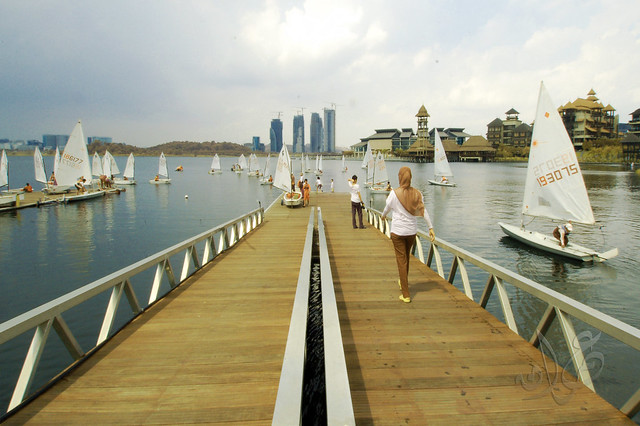Sejarah Putrajaya bermula dari sebuah tempat atau kampung terpencil dengan nama Prang Besar. Kampung ini berdekatan dengan Jenderam Hilir yang sekarang bersebelahan dengan Putrajaya. Prang Besar berasal dari nama seorang ketua kampung (orang asli) yang sanggup berperang dengan orang cina bintang tiga yang mahu merampas tanah orang asli bagi membina sebuah kem. Tentera bintang tiga telah membuat hura hara bagi mencapai hasratnya untuk mendapatkan tanah ini. Malangnya, tentera bintang tiga telah tertumpas kerana mereka tidak tahu yang sebenarnya ketua kampung ini seorang tok batin yang mempunyai ilmu harimau tanah hitam. Ilmu tersebut sangat kuat yang boleh menjatuhkan musuh dengan mudah. Meraka dikalahkan hanya menggunakan parang serta ilmu tersebut. Lalu tok batin mengusir tentera bintang tiga ini dari kampungnya. Begitulah serba sedikit mengenai asal dimana sejarah Putrajaya tercipta ditambah pula dengan maksud disebalik nama Putrajaya. 'Putra' dipilih sempena nama Perdana Menteri Malaysia yang pertama iaitu YTM Tunku Abdul Rahman Putra Al-Haj. Nama ini telah ditambah dengan perkataan 'jaya' yang bermaksud 'kecemerlangan'. Maka terjadilah Putrajaya yang anda ketahui sekarang.
Putrajaya melonjak membangun mulai 12 Oktober 1994. Ia dibangunkan oleh anak jati Malaysia sendiri berbanding Kuala Lumpur yang menjadi bandar tinggalan penjajah pada masa dahulu. Putrajaya yang dibina bercirikan budaya tempatan untuk tidak lupa akan warisan Malaysia.
Putrajaya telah menjadi Pusat Pentadbiran Kerajaan Persekutuan baru yang selama ini terletak di Kuala Lumpur yang sangat sesak dan pesat pada ketika itu. Ini juga merupakan salah satu faktor perpindahannya untuk mengurangkan kesibukan di Kuala Lumpur. Pembangunannya juga sejajar dengan polisi kerajaan untuk menyediakan pembangunan yang lebih seimbang dan efisien daripada sebelumnya. Kewujudan Putrajaya mencatatkan sejarah baru buat Malaysia dalam pembinaan bandaraya yang sangat moden tetapi masih mengekalkan ciri-ciri dan budya tempatan.
Selain itu, Putrajaya merupakan bandar contoh yang disertai taman yang lengkap dengan jaringan informasi berdasarkan teknologi multimedia yang serba canggih. Ia juga berdekatan dengan bandar Kuala Lumpur dan Lapangan Terbang Antarabangsa Kuala Lumpur (KLIA). Sangat memudahkan bagi mereka yang mencari tempat ideal merangkumi tempat pekerjaan, penempatan, bersukan dan juga pelbagai aktiviti rekreasi. Putrajaya menjanjikan kehidupan yang selesa dan berkualiti kepada penduduknya.
Kerja pembinaan bermula pada bulan Ogos 1995 dan telah diiktiraf sebagai projek 'real-estate' terbesar di Malaysia, malah di Asia Tenggara. Projek ini dijangka selesai pada tahun 2010. Pekerja-pekerja kontrak telah bertungkus lumus untuk menyiapkan fasa pertama Putrajaya yang dijadualkan siap pada minggu pertama bulan Jun 1999. Proses pembinaan Putrajaya dilaksanakan oleh tenaga kerja rakyat Malaysia sendiri begitu juga dengan bahan-bahan yang digunakannya. Hanya 10% sahaja diimport dari luar negara. Dalam tempoh 15 tahun, bandaraya ini akan siap sepenuhnya.

pelbagai tempat menarik yang ada di Putrajaya
Kini, Putrajaya menjadi antara tempat bersejarah bagi Malaysia. Ini kerana Putrajaya merupakan lokasi yang sangat menarik dan mempunyai pelbagai kemudahan seperti pusat sukan dan rekreasi, pendidikan, pusat membeli-belah, lebuh raya, pengangkutan, pelancongan serta pejabat-pejabat kerajaan yang selama ini berpusat di Kuala Lumpur. Malaysia harus berbangga dengan mempunyai lokasi seperti Putrajaya yang merupakan bandar moden dan maju seiring dengan negara luar.
sumber :- Google





